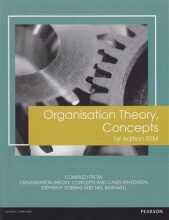Summary: Strategy Execution
- This + 400k other summaries
- A unique study and practice tool
- Never study anything twice again
- Get the grades you hope for
- 100% sure, 100% understanding
Read the summary and the most important questions on Strategy Execution
-
Lecture 1
This is a preview. There are 8 more flashcards available for chapter 18/10/2017
Show more cards here -
What is strategy execution in a nutshell and how does this relate to allignment?
1 Do the right projects;- Resources are often limited, decide which projects have priority
2 Do the projects right;- Focus on executing the chosen project well
3 Continually review and re-align.- Over time priorities change and project may become of lesser importance, or do not align with the company's strategy
Sometimes firms have capabilities, but their strategy does not allow to implement those capabilities. In this case, the CEO has to improve alignment between strategy, objectives and organizational capabilities. -
Why is strategy execution important?
Organization are good at formulating strategies but usually fail in the execution fase. Formulating strategy is difficult, making the strategy work -executing or implementing it throughout the organization- is even more difficult. -
Describe the strategy execution framework
The strategy framework consists of six integrated parts.
Strategy making (doing the right projects) consists of aligning (1) ideation, (2) nature, and (3) vision. Strategy execution consists of (5) Synthesis and (6) transition. Finally (4) Engagement connects strategy making and execution. -
Describe the link between identity and strategy?
Strategic identity determines the type of company. Wether firms activly manage their identity, firms make choices that manifest their identity in externally recognizable ways. Outsiders infer identity from external clues, such as dress code, code of ethics etc. External clues create de facto identity and shape the way the world relates to the firm. Strong identity determines a firm’s ability to compete; identity captures the essence as to what makes the firm different from others. -
Describe the category maturity life cycle Moore (2005)
In the early stages of a market's life cycle, the leading companies usually adopt a product leadership strategy. When the makerts mature these companies adopt either a customer intimacy of operational excellence strategy (although ambidexterious strategies exist). When the market is fully mature and starts to decline, disruptors often enter the market (or cause the decline), creating new markets and resetting the cycle. In this fase, new solutions are often developed and the knowledge of the industry is much wider, which contributes to the development of breakthrough solutions. -
Describe how companies can communicate their purpose
Internally: embed the purpose into the entire firm (e.g., through volunteer or employee developement programs that reflect it)
Externally: craft a mission statement that captures the essence of why the firm exists -
Describe the mission statement development process (Bart & Baetz, 1998)
- Clearly identify the corporate culture, values, strategy, and view of the future by interviewing employees, suppliers, and customers.
- Address the commitment the firm has to its key stakeholders, including customers, employees, shareholders, and communities
- Ensure that the objectives are measurable, the approach is actionable, and the vision is achievable
- Communicate the message in clear, simple and precise language
- Develop buy-in and support throughout the organization
-
Describe the difference between a vision and a mission statement
Vision statements describe the 'shape' of the future business, its sets specific goald and drives strategy. Vision expresses the mission strategy and values of the company at a particular time.
Mission statements state the basic purpose of the business, It defines the company's relationship to other organization, including competitors and sets general objectives. Mission statements are in a sense, timeless (or subject to change only infrequently). -
Lecture 2
This is a preview. There are 20 more flashcards available for chapter 19/10/2017
Show more cards here -
Describe the vision domain
The vision is the firm's road map, outlining both what the firm wants to become and guiding transformational initiatives by setting a defined direction for the firm's growth. The domain consists of:
Goal = the determinaton of specific desired results
Metrics = the vehicle to evaluate progress to the achievement of strategic goals
Strategy = the path an organizaton designs to achieve its purpose and goals -
Describe the purpose of goal setting in the vision domain
Goals are the determination of specific desired results. They translate ideation domain into numbers, which can make it possible to monitor the progress in an organization. It is important to translate long-range intention into specific goals. Articulate goals that are generally understood, widely communicated and clearly linked to the elements of ideation. Goals translate identity, purpose, and long-range intention into clear and tangible outcomes for the organization to accomplish. Goals are needed to emphasize the desired results rather than solely focusing on the process. Goals have to be SMART.
- Higher grades + faster learning
- Never study anything twice
- 100% sure, 100% understanding
































